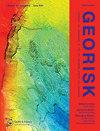基于动力模式分解的等效单自由度振动系统岩土动力学数据驱动近似
IF 4.8
3区 工程技术
Q1 ENGINEERING, GEOLOGICAL
Georisk-Assessment and Management of Risk for Engineered Systems and Geohazards
Pub Date : 2023-01-02
DOI:10.1080/17499518.2023.2184479
引用次数: 1
摘要
数据科学技术在岩土与地震工程中的应用是一个热门话题。本研究旨在利用动态模态分解(DMD)技术,从以往在地表观测到的地震运动记录中识别土壤的宏观动力特性。我们独创性的关键是用基于地面观测记录的单自由度(SDOF)振动模型取代土层组成和动力特性。在验证过程中,首先将所提方法与某SDOF振动系统的解析解进行了比较;其次,与考虑非线性土体剖面的一维等效线性多重反射理论分析进行了比较。该方法有效地将复杂的地面剖面近似为等效的SDOF振动系统,并根据观测到的地面地震运动建立了宏观伪剪切模量和阻尼常数的剪切应变依赖模型。这项研究是基于数值实验和小地震振幅的有限条件下,等效的线性近似可以作出。在本文研究结果的基础上,我们的目标是通过将模型改进为涵盖强非线性的实用模型,将模型扩展到广域预测。本文章由计算机程序翻译,如有差异,请以英文原文为准。
Data-driven approximation of geotechnical dynamics to an equivalent single-degree-of-freedom vibration system based on dynamic mode decomposition
ABSTRACT The application of data science technologies in geotechnical and earthquake engineering is a hot topic. This study aimed to identify the macroscopic dynamic properties of the soil from the previous records of seismic motions observed at the ground surface utilizing the dynamic mode decomposition (DMD). The key to our ingenuity was to replace the soil layer composition and dynamic properties with a single-degree-of-freedom (SDOF) vibration model based on the ground surface observation records. In the validation process, first, a comparison was made between the proposed method and the analytical solution for an SDOF vibration system; second, a comparison was made with a one-dimensional equivalent linear multiple reflection theory analysis considering the nonlinear soil profile. The proposed method effectively approximated complex ground profiles to an equivalent SDOF vibration system and constructed shear strain-dependent models of the macroscopic pseudo-shear modulus and damping constant from the observed ground surface seismic motions. This study was based on numerical experiments and limited conditions of small seismic amplitudes for which equivalent linear approximations could be made. Based on the results obtained in this paper, we aim to extend the model to wide-area forecasting by improving it to a practical model that covers strong nonlinearities.
求助全文
通过发布文献求助,成功后即可免费获取论文全文。
去求助
来源期刊
CiteScore
8.70
自引率
10.40%
发文量
31
期刊介绍:
Georisk covers many diversified but interlinked areas of active research and practice, such as geohazards (earthquakes, landslides, avalanches, rockfalls, tsunamis, etc.), safety of engineered systems (dams, buildings, offshore structures, lifelines, etc.), environmental risk, seismic risk, reliability-based design and code calibration, geostatistics, decision analyses, structural reliability, maintenance and life cycle performance, risk and vulnerability, hazard mapping, loss assessment (economic, social, environmental, etc.), GIS databases, remote sensing, and many other related disciplines. The underlying theme is that uncertainties associated with geomaterials (soils, rocks), geologic processes, and possible subsequent treatments, are usually large and complex and these uncertainties play an indispensable role in the risk assessment and management of engineered and natural systems. Significant theoretical and practical challenges remain on quantifying these uncertainties and developing defensible risk management methodologies that are acceptable to decision makers and stakeholders. Many opportunities to leverage on the rapid advancement in Bayesian analysis, machine learning, artificial intelligence, and other data-driven methods also exist, which can greatly enhance our decision-making abilities. The basic goal of this international peer-reviewed journal is to provide a multi-disciplinary scientific forum for cross fertilization of ideas between interested parties working on various aspects of georisk to advance the state-of-the-art and the state-of-the-practice.

 求助内容:
求助内容: 应助结果提醒方式:
应助结果提醒方式:


